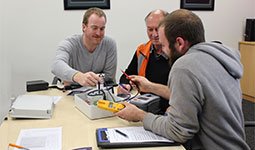
Electrical Safety
Working near electricity is dangerous and accidents can often be fatal. Because no device that can offer you 100% protection from electrocution, it’s important you remember to keep safe.
Overview
There are two ways that electricity can cause harm. First, electric shock (electric current passing through your body) can cause severe burns and potentially dangerous involuntary physical movements. Second, arc flash (release of energy) can result in blast injuries, lung injuries, ruptured eardrums, shrapnel wounds, severe burns, and blindness.
Common electrical hazards on a worksite
The electrical equipment you are using poses a big risk in the form of damaged equipment, incorrect tools for the job and tools being left on pose the biggest risk when it comes to the equipment itself.
The environment you are working in can have several hazards, such as power lines, underground services and excessive water.
The electrical supply you are using can easily become overloaded when there are many contractors on site, check sockets are not overloaded and the supply is earthed.
Workers themselves can be a hazard. Ensure your team is qualified and authorised to carry out electrical work. In addition, also keep an eye on fatigue and that people are not under the influence of drugs or alcohol.
General tips for working near electricity
- Use well-maintained, heavy-duty equipment
- Receive training on how to operate equipment safely
- Understand what the equipment should be used for
- Carry out planning (task analysis) to avoid tragedy.
- Display safety signage when electrical work is underway.
- Inspect cords, plugs and electrical equipment before each use. Repair or replace damaged equipment immediately.
- Use tape to secure extension cords to the wall or floor - don’t use nails or staples as they can cause a fire or shock.
- Avoid outlets or cords that have exposed wiring.
- Use extension cords and equipment rated for your type of work (i.e., commercial-graded equipment for work on site).
- Warm or hot outlets can be a sign that unsafe wiring conditions exist.
- Use ladders made with non-conductive materials (e.g., fibreglass).
- Locate the electrical panel and circuit breakers in case of an emergency.
- Clearly label circuit breakers and fuses.
Specific tips for working with electricity
Temporary Supply Switchboards
All temporary supply switchboards should:
- Be weatherproof and be designed to ensure accidental access to wiring cannot be made.
- Have door and locking facilities provided with a sign stating “Keep Closed – Leads Through Bottom”
- Have an insulated slot in the bottom to allow for leads
- Be locked where practicable
- Display signage to indicate that any work or alteration to the switchboard should be carried out by a registered electrician.
Residual Current Devices, Other Electrical Appliances Leads and Tools
A residual current device (RCD) should be at all source points of mains power and temporary supply switchboards. If practicable the RCD should incorporate into the temporary supply
- Only heavy-duty, commercial-quality electrical appliances, leads and tools should be used
- Never use piggyback plugs or domestic multi-boxes
- Keep leads away from water
- Don’t let leads become trip hazards, keep them tidy.
Power lines
A minimum working clearance of four meters is required. For distances closer than four metres, written authority is required from the electricity line owner.
Location of Underground Services
Before any excavation, the location of any underground electrical services should be identified and clearly marked.
Demolition
Before any demolition work, all electrical hazards should be identified and eliminated.
Any hazards identified during demolition should be isolated until they can be eliminated by a Registered Electrician.
Repairs
Electrical repairs or modification of appliances or tools should only be carried out by a person holding a Current Practicing License issued by the Electrical Workers Licensing Group.
Testing equipment
All electrical appliances, tools and leads should undergo regular testing - what we all know as ‘test and tag’. The frequency of testing a device is determined by where it is used:
- New appliances, before first use,
- Building sites, every three months,
- Factories, every six months,
- Most other applications, such as office equipment should be tested either yearly, or up to five years in some situations (seek professional advice).
- Use the inbuilt testing button to manually test RCDs before use
- Check all electrical appliance tools before use
- Where faults are detected, the appliance tool or lead should immediately be “out of action” and repairs carried out by a Registered Electrician before use
Regulations
The supply of power and use of electrical appliances and equipment should comply with the following:
- Electricity Act 1992
- Health and Safety at Work Act 2015
- AS/NZS 3760:2010 In-service Safety Inspection & Testing of Electrical Equipment
- AS/NZS 3012:2010 Electrical Installations Construction and Demolition Sites
- Approved Code of Practice for Demolition